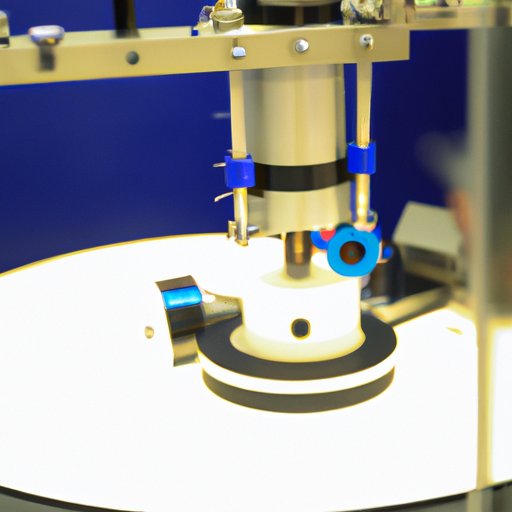Introduction
Photonics technology is a rapidly growing field of science that is revolutionizing the way we use light in modern society. In short, photonics is the study of using light or photons to generate, detect, and manipulate information. By harnessing the power of photons, scientists, engineers, and other experts are able to develop new technologies that can help us communicate better, improve medical diagnosis and treatments, and enhance efficiency in manufacturing and production.

Exploring the Basics of Photonics Technology: What it is and How It Works
Before exploring the many practical applications of photonics technology, it is important to understand what photonics is and how it works. Photonics is a branch of applied physics that focuses on the study and application of light. It involves the generation, emission, transmission, manipulation, and detection of light waves, as well as their interactions with matter.
At its most basic level, photonics technology works by manipulating the properties of light to create useful signals. Light can be used to transmit information, such as data or images, from one point to another. This is done by modulating the light signal, which means changing the properties of the light waves, such as frequency or amplitude. When the light reaches its destination, the signal is then demodulated, which means the original information is extracted from the light signal and converted back into a form that can be understood.

The Benefits of Photonics Technology for Everyday Life
One of the most important uses of photonics technology is in communications. By using light instead of traditional electrical signals, data can be transmitted much faster and over greater distances. This has enabled us to develop faster and more reliable wireless networks, as well as faster internet connections.
Another key benefit of photonics technology is its ability to improve medical diagnosis and treatments. Photonics technology can be used to create detailed images of the human body, allowing doctors to diagnose and treat conditions more accurately. For example, optical coherence tomography (OCT) is a type of imaging technique that uses light to take high-resolution images of the layers of tissue inside the body, making it possible to detect abnormalities at an early stage. According to a study by Harvard Medical School, “OCT has become an indispensable tool for diagnosing and monitoring retinal disease and other medical conditions.”
Finally, photonics technology has also been used to increase efficiency in manufacturing and production. By using lasers to precisely cut materials, manufacturers are able to reduce waste and increase productivity. Additionally, photonics-based sensors can be used to detect defects in products, allowing for higher quality control.
Photonics Technology for Scientific Applications
In addition to its everyday applications, photonics technology has also been used in a variety of scientific fields. One of the most notable examples is astronomy and space exploration. Telescopes equipped with advanced photonics-based sensors can detect faint light signals that are emitted from distant stars, galaxies, and other celestial bodies. This allows astronomers to observe objects that would otherwise be invisible to the naked eye.
Photonics technology has also been used in nuclear physics research. By using lasers to accelerate particles, scientists are able to study nuclear reactions in unprecedented detail. Additionally, photonics-based detectors have made it possible to measure radiation levels in nuclear reactors, helping to ensure safety and prevent accidents.
Finally, photonics technology has been used in biological imaging. By using techniques such as fluorescence microscopy, researchers are able to view living cells and tissues in great detail. This has allowed them to gain insights into the inner workings of the human body and its various organs, paving the way for breakthroughs in medical science.

Photonics Technology in Manufacturing and Production
Photonics technology has also been used in various manufacturing and production processes. Automation is one of the most important applications of photonics technology in this regard. By using laser-based sensors, robots can detect objects and identify the best way to manipulate them. This makes it possible to automate highly complex tasks, leading to increased efficiency and productivity.
Additionally, lasers can be used to precisely cut materials such as metal, plastic, wood, and glass. This makes it possible to create intricate designs with a high degree of accuracy, reducing waste and increasing productivity. Finally, photonics-based sensors can be used to monitor production processes and ensure quality control.
The Future of Photonics Technology: What’s Next?
As photonics technology continues to advance, there are many exciting possibilities for the future. One of the most promising areas is medical imaging. By using photonics-based imaging techniques such as OCT and MRI, doctors will be able to diagnose and treat diseases more quickly and accurately.
In addition, the use of photonics technology in automation is expected to expand. By using lasers and other photonics-based sensors, robots will be able to detect objects more quickly and accurately, making it possible to automate even more complex tasks.
Finally, photonics technology is expected to continue to revolutionize manufacturing and production processes. Laser-based manufacturing techniques are becoming increasingly sophisticated, allowing for more precise and efficient production. Additionally, photonics-based sensors are being used to monitor production processes and ensure quality control.
Conclusion
Photonics technology is a rapidly developing field of science that is revolutionizing the way we use light in modern society. By using light to generate, detect, and manipulate information, photonics technology has enabled us to develop faster and more reliable communication networks, improved medical diagnosis and treatments, and increased efficiency in manufacturing and production. Moreover, photonics technology is being used in various scientific fields, such as astronomy, nuclear physics, and biological imaging. As photonics technology continues to advance, there are many exciting possibilities for the future, ranging from improved medical imaging to expanded automation and new applications in manufacturing and production.
(Note: Is this article not meeting your expectations? Do you have knowledge or insights to share? Unlock new opportunities and expand your reach by joining our authors team. Click Registration to join us and share your expertise with our readers.)
